LISTEN IN APPLE PODCASTS | LISTEN IN SPOTIFY | LISTEN IN STITCHER
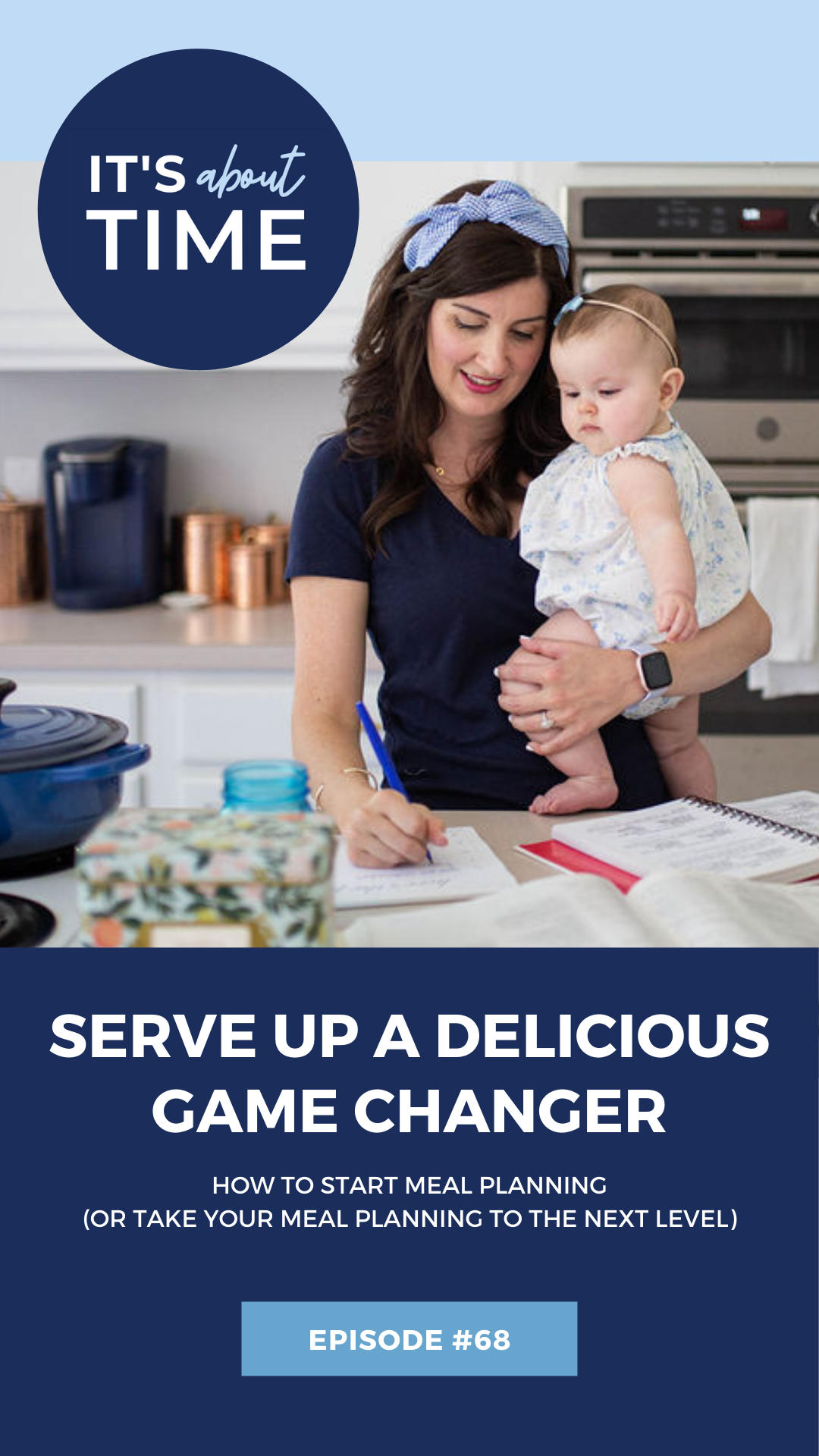
No one likes to be hangry. At least, I sure hope not. Because that would be weird. And if the term Hangry is an unfamiliar one – it’s a scary combination of Hungry and Angry. Also known as how you feel at 7PM when you’re standing in front of the fridge after a long day and all you have staring back at you is a bottle of hot sauce and two slices of cheese.
So you order takeout (or deliver) again, shell out more than you would have spent on groceries – and tell yourself that next time you’ll do things differently. And this episode is dedicated to exactly that.
Episode 68 is all about giving you the practical, tactical tips to either start meal planning or to take your current meal planning game to a very delicious, and time-saving next level.
So today, I’m covering
-
3 reasons why meal planning is such a game changer
-
What meal planning might look like for you so you can choose your own meal planning adventure
-
How you can get started with meal planning this week
-
The secret to making meal planning a habit you won’t ever want to give up
Grab your copy of Mastermind Your Meals – a quick and easy guide to planning 30 meals in 30 minutes or less.
This is the exact method I’ve used in the past, and it’s especially helpful if you’re starting a nutrition program like Whole30 or Weight Watchers.
If you’re like me and you hate grocery shopping – I always end up impulse buying things I don’t need – then I invite you to save $10 on a Shipt membership.
Shipt is a grocery delivery service that helps you save time AND money. We actually had Shipt groceries delivered this morning and our shopper, Paula, was an absolute delight.
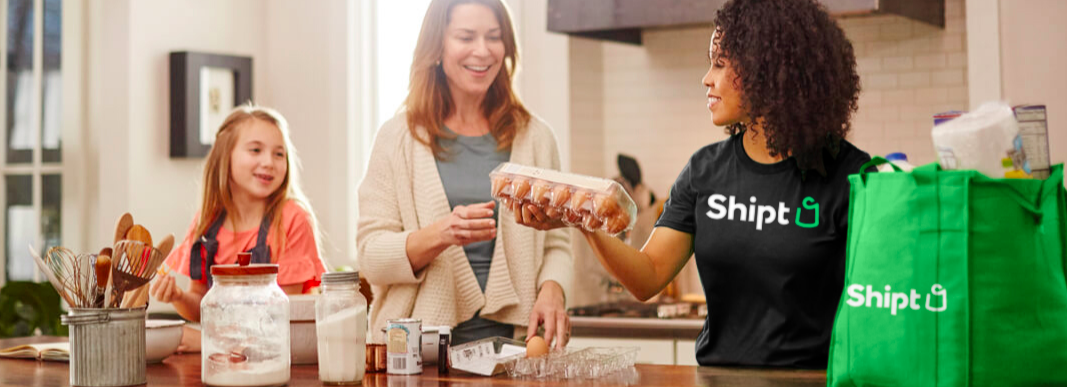
Image via Shipt.com
If you’re checking out these show notes, you probably fall into one of three camps:
-
You don’t meal plan.
-
You’re a die hard meal planner curious to find out if you might learn a few new tricks to up your game.
-
You’ve tried meal planning before, or maybe you do it once in a while – but it’s never really stuck.
Well – no matter which side of the menu you’re on – this episode has something for you.
So let me kick us off by sharing three reasons why meal planning is such a game changer.
Meal Planning is a Game Changer
01. – No one likes to be hangry.
Whether you’re a single lady, half of a couple or you’re a busy mom – that feeling of being hungry and frustrated isn’t a good look on anyone. Trust me – I know. I’ve been there. When I’m hungry, I get snappy and short tempered so I’ve learned to do everything I can not to let hungry turn into hangry.
Plus – research conducted at UNC Chapel Hill found that “Hunger as a state actually causes a lot of shifts in hormones, brain processes and the peripheral nervous system that are comparable to what we see in anger, fear and sadness.”
So being hangry isn’t just in your head – and fortunately it’s preventable.
If avoiding the hangry monster isn’t reason enough to start meal planning, having a plan for your plate helps combat decision fatigue.
02. – Meal Planning combats decision fatigue.
You’ve probably heard me talk about decision fatigue before, but as a quick refresher – decision fatigue describes how we gradually make worse and worse decisions over the course of a day. Basically we wake up with a gas tank that’s full of decision making ability. And as we make more and more decisions throughout the day – we use up that fuel… which is why most bad decisions are made in the evenings. And – making a decision about what you’ll make or eat for dinner in the evenings means that you’re saving a somewhat significant decision for a low fuel time of day.
So – by using your decision making fuel in the evenings to decide what you’ll have for dinner that night, you’ll using up even more of that decision making power – which makes you more susceptible to bad decisions later.
Cue the ice cream with chocolate syrup and sprinkles at midnight while impulse shopping instagram influencer posts from bed when you know you should just have a glass of ice water and turn off the light
Meal Planning – on the other hand – enables you to make all of the decisions about dinner for a week, or maybe two weeks or even a month – all in one sitting. So you’re able to be strategic about when and how you use that decision making gas in your tank.
And finally – we can’t talk about meal planning without talking about money.
03. Meal planning can save you money.
According to some quick research – the average cost of food for the typical American family ranges from $300-ish to $700-ish. And this varies based on cost of living in your city and the size of your family.
The typical American single spends between $150-$300 on groceries each month, and I pulled numbers for a few different cities.
-
Dallas-Fort Worth – $320/month
-
St. Louis – $350/month
-
Houston – $400/month
-
Washington D.C. – $465/month
Scott and I did the math a few months ago and found that we were spending WAY more than we should be on groceries. Even though we were meal planning, we found ourselves popping into the grocery here and there to pick up something we forgot – and inevitably adding a few extra things to our cart.
It is SO easy to let food spending run away with us – for several reasons. It’s not like paying a cell phone bill where we make one lump sum payment each month. Instead, we buy groceries one week, pick up a salad for lunch here, a coffee there – our food spending is scattered and all over the place, and when you’re popping into the grocery store multiple times a week to pick up something you can easily skyrocket your grocery spending without even realizing it. Like I said earlier when I told you about Shipt grocery delivery – I’m really bad about grocery store impulse buys and will totally toss a package of Oreo’s in my car, grab a few new Kombucha flavors I’ve never tried before and who knows what else if I don’t have a set plan in place.
Meal planning – even if it’s just lunches or just dinners – gives you the chance to do things like cook recipes that include enough for leftovers, or plan meals that share ingredients so you’re wasting less food.
And if you’re not a meal planner and you’re thinking – “Ugh – I get it, this sounds good but I like to be spontaneous! Sometimes I like to eat out! I don’t want to be tied down to a meal plan!” – then keep reading, because I’ve got a few ideas up my sleeve just for you.
Ok – so we’ve covered three of the big WHY’s behind meal planning:
-
No one likes to be hangry
-
Having a plan combats decision fatigue
-
And you can save on groceries.
I’m going to throw in one more.
Meal Planning saves you time.
Meal Planning saves you time. This is a no brainer. It’s less time spent in front of the fridge. Less time spent making decisions. Less time spent making multiple trips to the grocery store and less time spent answering the question “Hey – what’s for dinner?”
So let’s move on to the What.
What is Meal Planning?
What exactly is meal planning?
At it’s most basic level – Meal planning is simply choosing what you’ll eat in advance.

Photo credit: Sarah Becker Photography
It’s most commonly done on a weekly basis, but you could also plan a month’s worth of meals in one sitting if you really want to get next level.
Monthly Meal Planning
I’ve done this in the past – monthly meal planning – and created an entire free guide on how to plan 30 meals in 30 minutes or less that you can download by clicking here.
I’ve found that planning out a whole month’s worth of meals is especially helpful during super busy seasons of life, or when starting a new diet or nutrition plan. When Scott and I did Whole30 – which actually turned into Whole17 because we both got stomach bugs on day 17 and gave up… we planned meals for the whole month and it made life a lot easier. And even though we gave up on Whole30, we kept up the monthly meal planning for a while.
Right now, we’re changing things up and planning two weeks of meals at once. This has been really helpful to us from a budgeting stand point, and I’ll tell you more about how that’s working for us in just a bit.
But like with most things – there’s no one size fits all meal planning method. And thank goodness right? We all need to figure out what works best for us.
Meal planning could look like just mapping out your dinners, and letting your lunches be a little more spontaneous or free flowing. Or you could flip it and plan your lunches, but be more spontaneous with dinner. And of course – you can make a plan for everything – breakfast, lunch, dinner and even snacks if that tickles your fancy.
And if you’re someone who loathes the idea of being tied down to a specific menu – instead of choosing a set in stone dish for each night of the week, your meal plan could look like having recurring theme nights. This method worked especially well for one of my time management coaching clients.
She chose a different type of food for each night of the week – Mexican on Monday, Tuesday Italian, Wednesday slow cooker meal, etc. This gave her the ability to be creative and inspired with her cooking without starting from a totally blank slate.
So a few options you can work with:
Planning for a week, a month, or maybe 2 weeks
Planning Dinners only, Lunches only, planning ALL the meals or setting theme nights
How to Meal Plan
So let’s get into the How. How are we going to do this, or how are we going to do this better?
First we’re going to make a list.
Then we’re going to make some decisions.
And finally we’re going to make it happen.
Step 1 – Make a list.
Our very first step is to create a bank of our favorite meals. And no, it can’t live in your head. You’ve got to get it out of your head and either onto paper or somewhere digital.
You cannot skip this step. It’s absolutely key to making meal planning work on a regular basis. Once you do this, it’s super easy.
Ok – so how do we create this bank and where does it live?
Well – where do your recipes currently live? Are they scattered across iPhone screenshots, bookmarks in your browser, Pinterest boards and magazine tear outs?
It’s time to get them all in one place.
PUT THEM IN A RECIPE BOX
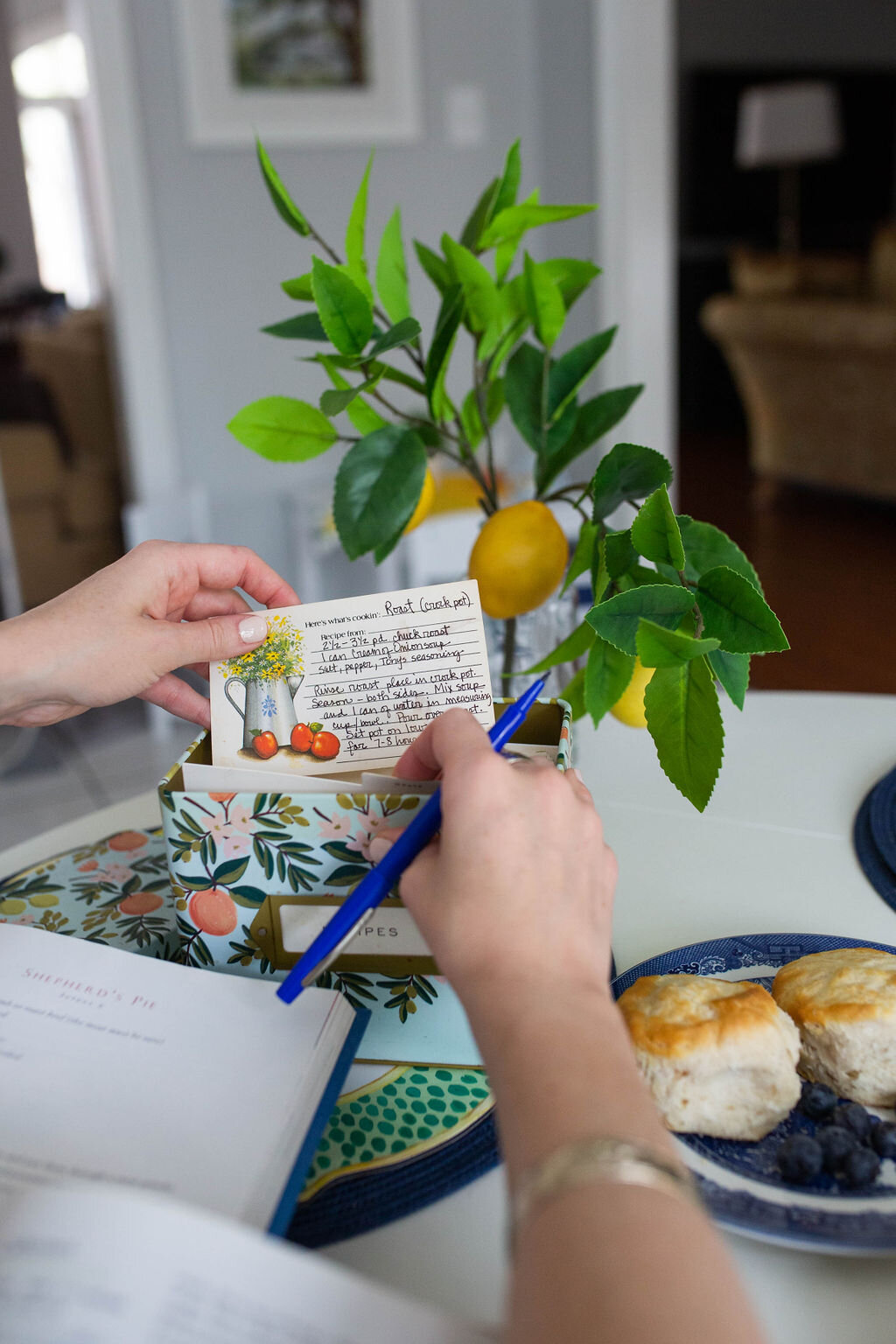
Photo Credit: Sarah Becker Photography
I have a cute little Rifle Paper Co recipe box where all of our favorite recipes live.
I put together my recipe bank by rounding up my go-to recipes from various cookbooks, and my random magazine tear outs and various Pinterest boards and wrote them down on little recipe cards. Yes – this took time, but now everything lives in one place, and as I choose meals for the week, I pull out the cards and put them in a little recipe card stand thingy on my counter. After we cook that meal, the card goes back in the box. Easy peasy.
KEEP THEM IN A BINDER
My friend Jenny made a recipe binder. She compiled all of her favorite family meals that were living on various websites, Pinterest boards and torn out magazine pages into a single binder that she can grab and thumb through whenever she sits down to plan meals for the week. That’s genius – I love it.
SAVE THEM IN A DIGITAL SPOT
If you’re more of an iPad in the kitchen digital kind of girl, consider creating a Trello Board or an Asana Project – or insert your task management tool of choice – that houses links to your favorite recipes. Of if you use Evernote or Google Keep – create a space just for your go-to recipes.
It doesn’t matter WHERE your recipes live, as long as they all live TOGETHER and not in your head. You want to create a one-stop shop to pull your favorites while you’re planning your meals.
Step Two – Make Some Decisions
01. WHEN YOU’LL PLAN
First – decide WHEN you’ll plan your meals.
-
Are you going to do meal planning as a part of a weekly planning session? That’s when we plan our meals. After I review my calendar for the week ahead, I plan our meals based on our family’s schedule. If I’ve got an exceptionally busy week ahead with coaching or podcast recordings or if Scott knows he has to work late on a specific evening, I’ll plan simpler one-pan meals or dishes that make a lot of leftovers. The slow cooker is my BFF.
-
It doesn’t matter when you plan your meals, as long as you decide in advance and stick to it. And I’m not saying you have to plan your meals at 9AM every Sunday morning – my weekly planning session shifts around -but it’s easier to be consistent and make meal planning a habit when you know when you’re going to make your plan.
02. WHAT YOU’LL PLAN
Next – once you decide WHEN you’ll plan your meals, decide WHAT you’re going to plan
-
Are you going to do all meals?
-
Meals AND snacks?
-
Dinners only?
-
Weekdays only?
-
Are you going to give yourself a floating takeout night each week?
-
Set some parameters for picking up takeout for lunch?
-
For example – Right now, we have a rule that we can only pick up fast food or take out for lunch once a week. And we’re aiming to do takeout or dine out for dinner no more than twice a month.
-
This isn’t exactly a meal but a few years ago when I worked at a PR firm with a great coffee shop within walking distance, I made a rule that I could only grab coffee twice a week. Tuesdays – the day of our weekly early meeting – and one floating day. Otherwise, I would have gone every day and again… that adds up quickly – especially when you throw in a chocolate chip cookie or a cake pop.
03. HOW MANY MEALS YOU’LL PLAN
Once you’ve decided When you’ll meal plan and what you’re actually planning, you’ve got to decide how long you’ll be planning for…
Weekly
-
Weekly meal planning is probably the most common and is a great place to start if you’re new to the meal planning thing.
-
One thing Scott and I found with weekly meal planning is that we got stuck in a rut. We were accidentally eating the same 3-4 things each week, and while it was super easy and saved us a ton of time – it got really boring.
Monthly
-
That’s one of the reasons why we moved up to monthly meal planning. Looking at the whole month at once gave me the ability to space out those go-to meals and make sure that I wasn’t accidentally making the same things over and over again.
-
With monthly meal planning, I’d scatter our go-to’s across the month, and then add in other dishes that were different but used similar ingredients in order to maximize our grocery purchase. I mean – how many times have you bought an entire bunch of parsley or cilantro when you only needed a little bit for one recipe… and then you throw the rest away. Ugh – I hate that.
-
Monthly meal planning also inspired me to look for new recipes to try – pulling out my cookbooks and ripping pages out of Southern Living magazine, and once they became favorites they earned a spot in the recipe box.
Two Weeks
-
Recently, however, Scott and I have shifted to planning two weeks of meals at once. And here’s why – basically – after running some numbers, we realized that we were overspending on groceries. By a lot.
-
We were sticking to our meal plan, but were adding in impulse buys and not really staying within a specific budget.
-
So – now we set our grocery budget for the month, and map out two weeks of meals in one sitting, doing our best to strategize recipes with similar ingredients. Then, we put all of our groceries for those two weeks of meals into Shipt and check the price. If it’s half or less of our monthly budget, we’re good. If it goes over the halfway mark, we rework the menu and see what we can cut or swap to stay under our number.
-
You can do this same method with a weekly meal plan – but we’ve found that two weeks works pretty well for budgeting.
04. WHERE YOUR MEAL PLAN WILL LIVE
Ok – Last decision to make before we make it happen, and that’s deciding Where your meal plan will live.
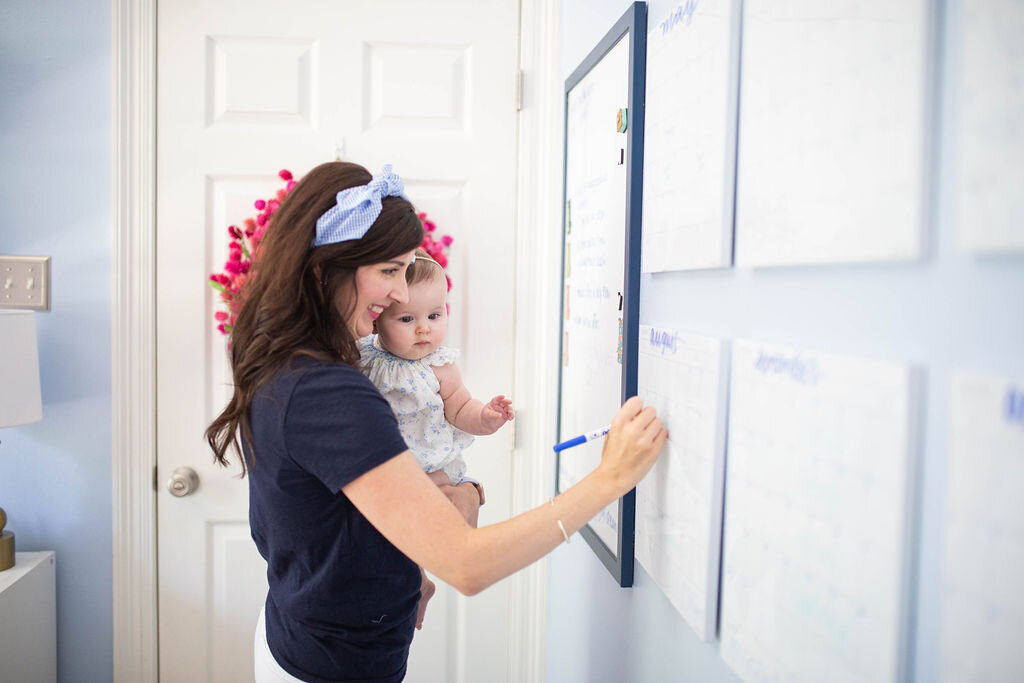
-
The go-to tends to be a dry erase calendar in a command center type spot, or a magnetic tear off notepad on the fridge door. But there is ZERO need to wait for a fancy calendar or notepad to start meal planning. You can write it with a crayon on a sheet of looseleaf and tape it to the wall and it’s just as effective.
-
The point is that it’s posted somewhere you – and others in your family – can see it.
-
Our family’s two-week meal plan has been living on the monthly pages of my Simplified Planner, which I’ll definitely link in the shownotes. But in addition to it living in my planner, I would also write the meals for the week on a small weekly dry erase board in our family command center located in the back hallway. This way – I never had to answer the question – What’s for dinner? Because it was posted up on the meal planning board.
-
In our new home, we have a much larger back hallway, and I’ve purchased a monthly dry erase calendar that I’ll be using for meal planning.
-
Really – whatever works for you, whatever you have space for, and whatever you’ll keep up with. But you have to decide where it will live – because it you put your meal plan in a different spot every time, you’ll lose track of it, you’ll get frustrated, and you’ll give up.
Ok – Quick recap of those decisions:
Decide
-
When you’ll make your plan
-
What meals you’ll plan
-
How long you want to plan for – weekly, monthly, whatever
-
And Where your plan will live
Step 3 – Make it Happen
And finally – Step three – Make it happen.
Do you first – or your next – Meal Planning Session.
And then reward yourself with a treat.
And by treat, I don’t mean 12 impulse buys at the grocery. But choose some type of treat – and it doesn’t even have to be food! Your treat can be watching an episode of your favorite TV show or buying some sassy earrings or something totally different. But – if you’re new to meal planning, having an external reward is going to keep your meal planning habit going while you’re waiting for the internal reward to kick in. And buddy – it will definitely kick in.
Meal Planning is Amazing
Meal planning just makes life easier. And you feel the benefits of it quickly – whatever those benefits are for you. It could be the time you save, it could be feeling less hangry in the evenings, it could be losing weight because you’re making healthier choices in advance, or saving cash money because you’re buying less takeout and delivery.
If you’ve never meal planned before, I challenge you to give it a shot in the next week. Make your recipe bank and get after it. If you’re a regular meal planner, or if you’ve dabbled but it hasn’t stuck – I challenge you to take one of the tips you’ve learned in this episode and use it in the next week to take your meal planning game to the next level.
I can’t wait to hear if you start meal planning, or if you try something new to up your game and make mealtimes more delicious. Pop over to the It’s About Time Academy and tell us all about it!
LINKS & RESOURCES MENTIONED IN THIS EPISODE
FREE RESOURCES
-
Download Mastermind Your Meals – my free monthly meal-planning guide
TOOLS
-
My planner where I write out my meals on the monthly pages
LISTEN
JOIN
-
Join the It’s About Time Academy!

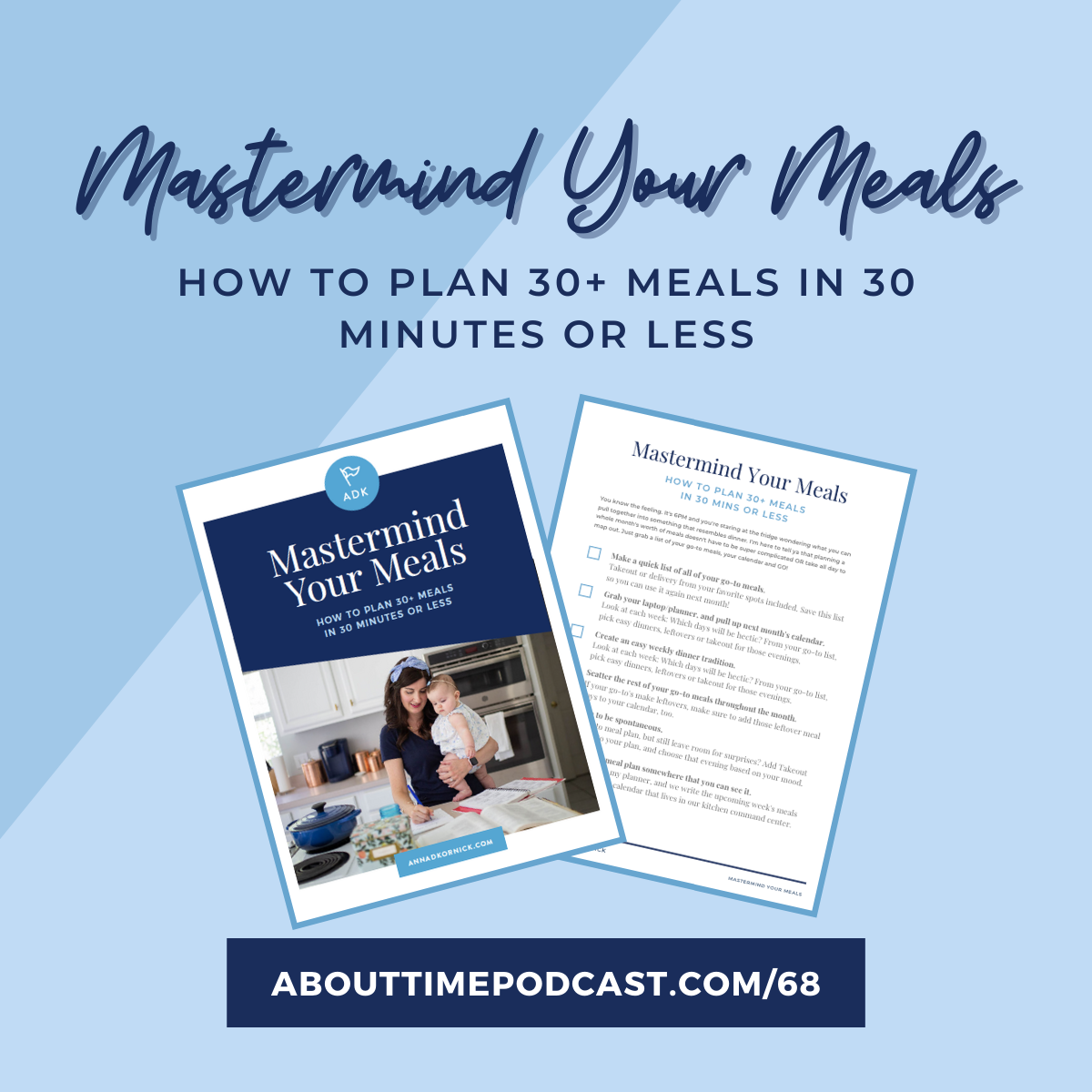

Be the first to comment